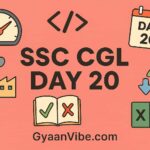GyaanVibe is a focused educational platform dedicated to helping SSC CGL aspirants crack Tier 1 & Tier 2 exam with a strategic, day-wise, and well-structured preparation approach.
SSC CGL Preparation – Day 20
Quantitative Aptitude – Speed, Time, and Distance (Advanced)
✅ 1. Key Concepts Recap
🔹 Basic Formula:
$$\text{Speed} = \frac{\text{Distance}}{\text{Time}} \quad \text{or} \quad \text{Distance} = \text{Speed} \times \text{Time}$$
🔹 Units Conversion:
- $$1 \text{ km/hr} = \frac{5}{18} \text{ m/s}$$
- $$1 \text{ m/s} = \frac{18}{5} \text{ km/hr}$$
🔹 Average Speed:
If a body covers a certain distance at two different speeds: $$\text{Avg. Speed} = \frac{2xy}{x + y}$$
Where xxx and yyy are two different speeds for equal distance.
✅ 2. Common Problem Types
🔸 A. Relative Speed:
- Same direction: Subtract speeds
- Opposite direction: Add speeds
🔸 B. Meeting Point Problems:
If two people start from opposite ends and move towards each other: $$\text{Meeting Time} = \frac{\text{Total Distance}}{\text{Relative Speed}}$$
🔸 C. Train Problems:
- A train of length LLL crossing:
- A pole: Time = $$\frac{L}{S}$$
- A platform of length PPP: Time = $$\frac{L + P}{S}$$
- A man running: Use relative speed
🔸 D. Boat and Stream:
- Downstream speed: u+vu + vu+v
- Upstream speed: u−vu – vu−v
Where:- uuu = Speed of boat in still water
- vvv = Speed of stream
$$\text{Time} = \frac{\text{Distance}}{\text{Speed}}$$
✅ 3. Advanced Cases & Tricks
🔸 1. Crossing Each Other
Two trains of lengths L1 and L2 and speeds S1, S2 cross each other in:
$$\text{Time} = \frac{L_1 + L_2}{S_1 + S_2}$$ (if in opposite directions) — ###
Late/Early Arrival Let: – Actual speed = ( S) – Time difference = (t) – Distance = (D)
Then: D = $$\frac{(S_1 \cdot S_2 \cdot t)}{|S_1 – S_2|}$$
✅ 4. Examples
Q1. A train 120 m long crosses a pole in 6 seconds. What is its speed?
Solution:
Speed = $$\frac{120}{6} = 20 \text{ m/s} = 72 \text{ km/hr}$$
Q2. A train 150 m long crosses a platform 150 m long in 15 seconds. What is the speed?
Solution:
Distance = 150 + 150 = 300 m
Speed = $$\frac{300}{15} = 20 \text{ m/s} = 72 \text{ km/hr}$$
Q3. A man travels 60 km at 20 km/hr and returns at 30 km/hr. Find average speed.
Solution: $$\text{Avg Speed} = \frac{2xy}{x + y} = \frac{2 \times 20 \times 30}{20 + 30} = \frac{1200}{50} = 24 \text{ km/hr}$$
Q4. A boat covers 24 km downstream in 3 hours and the same distance upstream in 6 hours. Find speed of boat and stream.
Solution:
Downstream speed = 8 km/hr
Upstream speed = 4 km/hr
Boat speed = $$\frac{8 + 4}{2} = 6$$
Stream speed = $$\frac{8 – 4}{2} = 2$$
Q5. Two trains of length 100 m and 120 m moving in opposite directions at 50 km/hr and 60 km/hr. Find the time to cross each other.
Solution:
Relative speed = 50 + 60 = 110 km/hr = $$\frac{110 \times 1000}{3600} = 30.56 \text{ m/s}$$
Total length = 220 m
Time = $$\frac{220}{30.56}$$ ≈7.2 seconds
✅ 5. SSC CGL Tips & Shortcuts
- Always convert km/hr to m/s when working with meters and seconds.
- For trains, total length is important — always add if crossing a platform or another train.
- Use relative speed logic for boats, trains, and people walking/running.




